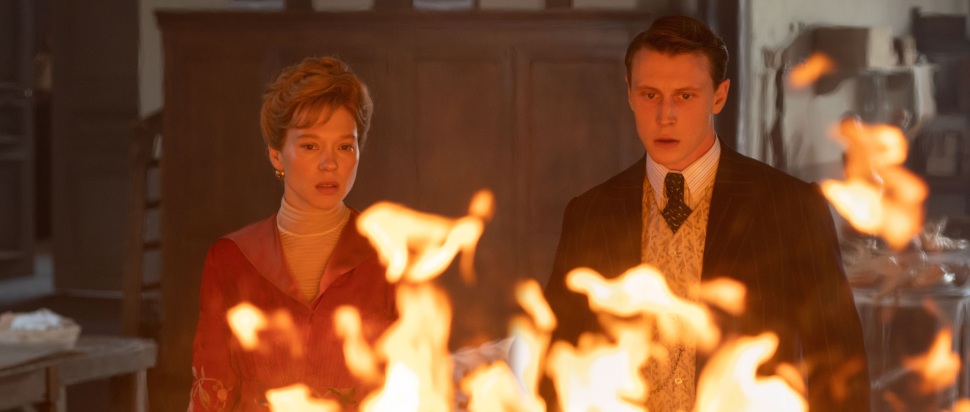Rule of Three: George MacKay on The Beast
George MacKay shows off his acting versatility – and his French skills – in the inventive sci-fi The Beast, where he performs three versions of a character across three timelines. He tells us more about this thrilling and wildly ambitious film
George MacKay is a nice guy, both IRL and in movies. On-screen, he’s made a career out of playing lovely young men who are deeply traumatised in one way or another. He’s best known as the stoic hero of Sam Mendes’ balletic war film 1917, while other signature performances include a salt-of-the-earth Edinburgh squaddie on leave in Proclaimers musical Sunshine on Leith and the adorable youngest member of the lesbian and gay union supporters in Pride. But some surprisingly hard edges have been creeping into his recent roles. He gave a tough, sinewy turn as Aussie folk hero Ned Kelly in The True History of the Kelly Gang and in the recent Femme, he’s terrifying as a closeted thug who begins the film beating up a drag queen. In both films, a softer side is revealed below the tough facade, but it’s startling to see MacKay in this forceful mode after years of gentle performances.
“I guess it’s a gut instinct that drew me towards these characters,” he says when I ask about this recent run of edgier roles, although he admits he is conscious of trying to keep things fresh too. “I've always admired actors who you can't place too much and who change it up in terms of the characters they play,” he says. “I'd be very wary of getting in a zone; I don't want to be an actor who does one type of role.”
This versatility must have been useful in his new film The Beast, from talented French director Bertrand Bonello. It’s a hugely ambitious sci-fi romance brimming with existential dread. Léa Seydoux stars as Gabrielle, a young woman living in 2044 who’s undergoing a procedure that will temper her emotions. It involves immersing herself in a vat of black goo, which allows her to reexperience and 'cleanse the DNA' of past lives. MacKay’s character is Louis, or should I say characters? Gabrielle encounters Louis across three timelines, and in each, he looks and speaks differently. In 1910 he’s an English gentleman visiting Paris; in 2014, he’s a dangerous incel roaming the Hollywood Hills; and in 2044, he’s a suave Frenchman considering going under the same procedure as Gabrielle.
“Louis is a dream of a part because he's three parts,” confirms MacKay. The role came his way under tragic circumstances. Bonello had written the film with his regular collaborator Gaspard Ulliel in mind for Louis, but Ulliel died in a skiing accident only a few months before cameras were due to start rolling. “Bertrand wanted to continue the film,” explains MacKay, “but the role was written for Gaspard; he was the only French actor Bertrand wanted. So he decided to look outside of France, and then it became an audition process.”
MacKay adored the script and Bonello’s wild vision. “I've never read anything so existential and romantic. [Bertrand] was taking such a big swing at all of those themes.” The film is inspired by Henry James’s 1903 novella The Beast in the Jungle, about a man who lives in a constant state of fear of the titular creature, which is essentially James’s metaphor for living a life too cautiously. Bonello takes James’s premise in some thrillingly heady directions, and imbues each time period with its own specific tone (one is a melodrama, one is a horror, one is pure dystopian sci-fi). It’s a troubling, provocative, incredibly brainy film held together by the emotional anchor provided by Seydoux and MacKay.
“The through line that binds both characters is a mutual fear of love,” explains MacKay. “The recognition of that fear in each other bonds them, but it also keeps them apart. So if you've got that fear as the spine of this character Louis, the question was, how does that articulate in 1910? And how has that been turned inwards in 2014? And how does that go in 2044? It was just the perfect role to question what makes an identity, which I’m really interested in.”
The Beast is MacKay’s finest performance to date, but when I ask for his personal favourite, he immediately cites 2019’s The True History of the Kelly Gang. “That was really important to me as a role,” MacKay says. “It kind of recalibrated everything in my head as an approach and the possibilities of the work.” He's full of praise for its uncompromising director, Justin Kurzel, who made the harrowing true-life serial killer drama Snowtown and a gloomy, blood-drenched version of Macbeth on the Isle of Skye; Kurzel was the chief reason for that shoot being so pivotal. “The way in which Justin would come at things kind of sideways and reinvent things was incredible – but also the rigour that he worked with too. The film just meant the world to me.”
MacKay’s next project is with another master filmmaker: Joshua Oppenheimer. It’s titled The End. Tilda Swinton plays MacKay’s mother and it’s rumoured to be a musical – a genre MacKay knows well from Sunshine on Leith. “I don't know how much I can say,” MacKay says cautiously of The End, “but yeah, it's a musical. It's the story of a family who live in a bunker after the end of the world, who've kept themselves safe, and it is a kind of an exploration on, I guess…” he stops himself. “I'm wary of saying too much.”
I don't push more, but do wonder if the songs are trickier than I'm on My Way and I'm Gonna Be (500 Miles)?
“They are?” laughs MacKay. “The amazing Josh Schmidt did the music; it’s A+ orchestration.”
The Beast is released 31 May by Vertigo
